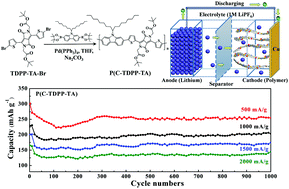Functional thiophene-diketopyrrolopyrrole-based polymer derivatives as organic anode materials for lithium-ion batteries†
Abstract
In this study, four thiophene-diketopyrrolopyrrole-based (TDPP-based) polymer derivatives modified by different groups and alkyl chains were synthesized. The effects of various functional groups on the electrochemical properties of the polymers for application in lithium-ion batteries were compared, where the carbazole (C) and tert-butyl acetate (TA) groups improved the capacity performance of the polymer electrodes, while hexane (H) and fluorene (F) groups enhanced the cycle stability of the polymer electrodes. The P(C-TDPP-TA) polymer electrode, i.e., the TDPP-based polymer composed of carbazole and tert-butyl acetate groups, exhibited the best capacity performance among the four polymer electrodes, where its discharge specific capacity and capacity retention were up to 357 mA h g−1 and 82% and its energy density and power density were 213 W h kg−1 and 149 W kg−1 at 100 mA g−1 after 500 cycles, respectively. The P(F-TDPP-H) polymer electrode, i.e., the TDPP-based polymer composed of fluorene and hexane groups, possessed the best cycle stability and conductivity, where its capacity retention was up to 92% at 100 mA g−1 for 500 cycles and its electronic conductivity and ionic conductivity were 4.80 × 10−3 and 6.68 × 10−3 S m−1, respectively. For application in lithium-ion batteries, the P(C-TDPP-TA) electrode exhibited the best comprehensive performance. When the current density reached up to 1000 mA g−1, after 1000 cycles, the P(C-TDPP-TA) electrode still exhibited a high discharge specific capacity (203.6 mA h g−1) and excellent capacity retention (88.8%), and its energy density and power density were 116 W h kg−1 and 376 W kg−1 (1000 mA g−1, after 1000 cycles), respectively. Therefore, the P(C-TDPP-TA) electrode has potential as a promising anode material for lithium-ion batteries.



 Please wait while we load your content...
Please wait while we load your content...